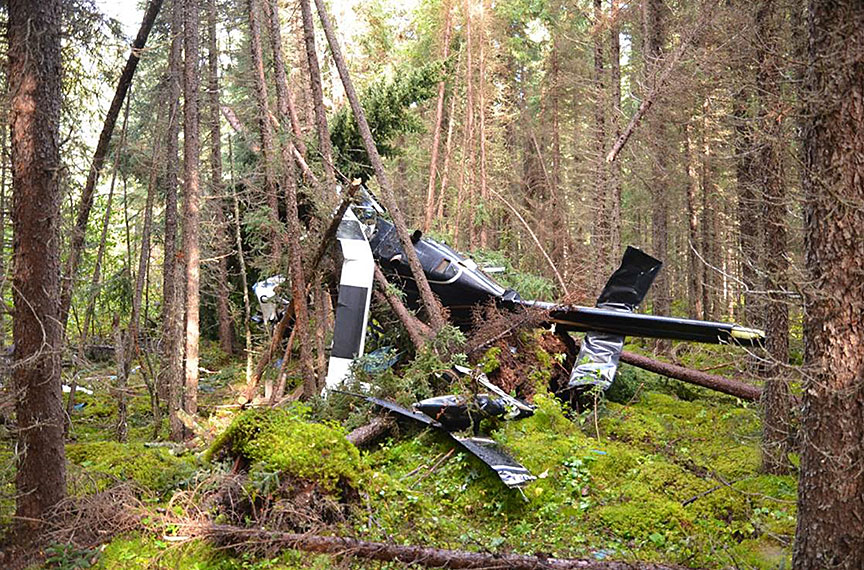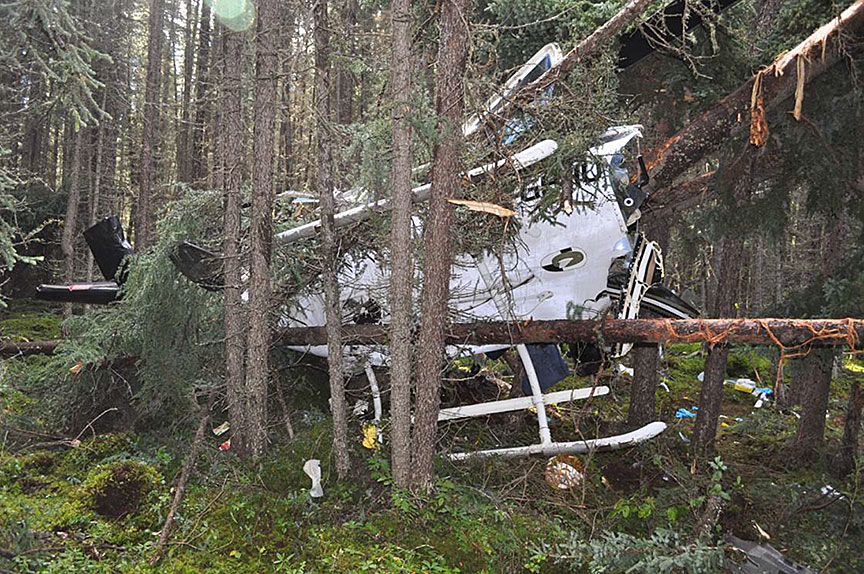Running on Fumes: Fatal Canadian Helicopter Accident
In its investigation report into a fatal accident to Bell 206B Jet Ranger C-GHHU operated by Ridge Rotors. the Transportation Safety Board of Canada (TSB) concluded that the absence of a specific minimum fuel quantity was a key factor in a survey helicopter’s loss of power and collision with trees.
History of the Flight
On 5 September 2016, the helicopter was operating a daytime flight to survey mountain pine beetle near Whitecourt, Alberta with the pilot and two surveyors on board.
This environmental survey task required the helicopter to be operated for significant periods of time at low altitudes and speeds.
[When] surveyors identify an area that requires closer inspection, the helicopter…circles the subject trees. It descends to 60 feet above the treetops and makes a slow pass (at less than 15 mph) over the affected trees so that the surveyor can mark the spot with a GPS-enabled computer. The slow pass is required for accurate GPS plotting because locations must be within 30 m of the subject trees.
The height/velocity “avoid” area for a B206B is defined as less than 200 feet AGL at an airspeed below 40 mph.
At around 15:20 local time, while flying 160 feet above ground, the helicopter suddenly lost engine power and, within seconds, descended, colliding with trees.

Wreckage of Ridge Rotors Bell 206B Helicopter C-GHHU (Credit: TSB)
The surveyor sitting in the front was fatally injured when trees penetrated the cockpit. The pilot, who was wearing a helmet, unlike the passengers, sustained serious injuries and the other surveyor escaped with minor injuries. The 406 MHz ELT activated and the signal was received by the Cospas-Sarsat search and rescue satellite system.

Fuel Management
The fuel requirements for helicopters operated day VFR in CARs paragraph 602.88(3)(b), are for sufficient fuel “to fly to the destination aerodrome and then to fly for a period of 20 minutes at normal cruising speed.”
An optional FUEL LOW caution light can installed by operators of Bell 206B helicopters. This activated when fuel drops to approximately 20 USG. C-GHHU did not have the FUEL LOW caution light installed. If fitted, the Rotorcraft Flight Manual (RFM) action would be “land as soon as practical”.
Earlier, at 14:48, after 2 hours and 20 minutes of surveying, C-GHHU landed on a gravel bar by the Little Smoky River for a rest break.
The pilot and the surveyor in the front left-hand seat discussed the fuel remaining. The pilot indicated that 30 USG of fuel remained, which would allow for about 1 hour of flight, including reserve fuel. From the surveyor’s perspective, the fuel quantity gauge appeared to indicate approximately 24 USG.
The pilot however decided to continue with the surveying operations before proceeding to the company fuel cache located at Fox Creek Airport approximately 12 nm away. Fuel burn would be 28 USG/hour at the Rolls-Royce Cruise B (75%) performance rating.
The TSB say that Ridge Rotors’ practice of regularly operating helicopters with low fuel levels likely influenced the pilot’s decision:
A review of company documentation showed that it was common practice to conduct survey flights of more than 3 hours between refuelling stops. It was not uncommon for survey flights to land with 10 USG of remaining fuel. The journey logbook for C-GHHU showed 10 occasions in the 3 weeks prior to the accident when the helicopter was operated with multiple flight legs lasting over 3 hours.
Such norms have been factors in other recent fatal accidents (see below):
The investigation determined that company pilots were using several different fuel‑burn rate estimates for flight operations, ranging from 23 to 30 gallons per hour (GPH).
The Ridge Rotors operations manual describes general company refuelling procedures. The procedures direct the pilot to confirm…the right quantity of fuel has been loaded. Fuel-loading data was not recorded in the aircraft journey logbooks. This practice was compliant with CARs section 605.94.
Moments before the accident, the helicopter entered a left turn which likely resulted in air entering the fuel pumps, interrupting fuel flow and causing an engine power loss.
Investigators concluded that low altitude survey work in combination with low fuel levels and the inactive automatic ignition system (only used by the operator in snow) contributed to the inability to recover from the engine power loss.
The TSB say:
It is important for operators to understand the limitations of the Bell 206B helicopter fuel system and the risks associated with flights conducted with less than 20 US gallons of fuel. If operators do not observe the minimum fuel quantities recommended in the flight manual, there is a risk that the helicopter will be operated at fuel levels conducive to engine power loss.
As this occurrence demonstrates, some operators are not managing safety risks effectively.
Safety Management
Operators of this type in Canada (CARs subparts 702 Aerial Work and 703 Air Taxi Operations), and many others, are not required to have a safety management system (SMS).
The company did, however, have a system to manage safety…[which]… included a formal risk management process that was applied to some of the hazards identified by the company. There was no information provided to show implementation dates and follow‑up dates associated with the risk assessments. Ridge Rotors safety management did not use a thorough risk analysis process to address the hazards and risks associated with this type of survey flying.
During the occurrence flight, C-GHHU spent 1 hour and 48 minutes in the survey area. Of this time, approximately 34 minutes, or 32% of the flight time, was spent within the “avoid” area of the height/velocity diagram.
H-V Diagram from the B206B RFM (Credit: Bell via TSB, with TSB Annotation)
The operator had also introduced a checklist item at their own initiative
The TSB note that they have…
…repeatedly emphasized the advantages of an SMS, recommending that Transport Canada require all commercial aviation operators in Canada to implement a formal SMS (A16-12).
To date, the Board has been unable to assess Transport Canada’s response to this recommendation because Transport Canada has not specified the actions that will be taken to implement a formal SMS.
Safety Actions
Transport Canada conducted a “process inspection” of Ridge Rotors after the accident and the operator implemented corrective action plans to address “6 minor findings of non-compliance” in pilot training, weight and balance, maintenance control and quality assurance.
Ridge Rotors now requires the auto relight system to remain on during all phases of flight. This change has been incorporated into the company’s standard operating procedures, and pilots have been trained accordingly.
No change to their SMS is reported nor are specific interventions on fuel management or organisational culture.
Safety Resources
See our earlier reports:
- How a Cultural Norm Lead to a Fatal C208B Icing Accident
- All Aboard CFIT: Alaskan Sightseeing Fatal Flight – another case with adverse cultural norms about weather
- Execuflight Hawker 700 N237WR Akron Accident: Casual Compliance
- HEMS Black Hole Accident: “Organisational, Regulatory and Oversight Deficiencies”
- Culture + Non Compliance + Mechanical Failures = DC3 Accident
- Impromptu Flypast Leads to Disaster, begging more questions on organisational culture.
- Fatal H500 Low Altitude Hover Power Loss: Power Line Maintenance
- Canadian KA100 Fuel Exhaustion Accident
- Fuel Exhaustion Causes EMB-110 Emergency Landing
- UPDATE 7 April 2018: Investigators Criticise Cargo Carrier’s Culture & FAA Regulation After Fatal Somatogravic LOC-I.
- UPDATE 1 September 2019: King Air 100 Stalls on Take Off After Exposed to 14 Minutes of Snowfall: No De-Icing Applied
- UPDATE 4 July 2020: A Baffled Attitude Fuel Starvation Accident
- UPDATE 1 January 2022: Snagged Sling Line Pulled into Main Rotor During HESLO Shutdown
- UPDATE 19 November 2022: Whiteout During Avalanche Explosive Placement
UPDATE 15 August 2018: An ATSB report and Safety Advisory Notice on another helicopter fuel related air accident: Fuel exhaustion and collision with terrain involving McDonnell Douglas Corporation 369, VH-PLY, 36 km NW Hawker, South Australia, on 17 July 2016
Aerossurance is pleased to be supporting the annual Chartered Institute of Ergonomics & Human Factors’ (CIEHF) Human Factors in Aviation Safety Conference for the third year running. We will be presenting for the second year running too, this time on the subject of the FSF‘s Maintenance Observation Programme concept.
 This year the conference takes place 13 to 14 November 2017 at the Hilton London Gatwick Airport, UK with the theme: How do we improve human performance in today’s aviation business?
This year the conference takes place 13 to 14 November 2017 at the Hilton London Gatwick Airport, UK with the theme: How do we improve human performance in today’s aviation business?



Recent Comments